Mulch: Everything You Need To Know
Nothing is more satisfying than looking at a freshly mulched flower bed - the clean lines, contrasting colors, and not a weed.
It gets you excited for the spring and summer!
After all, when your flower bed has fresh mulch, your home is ready for summer BBQs, hosting friends, and enjoying the beautiful outdoors!
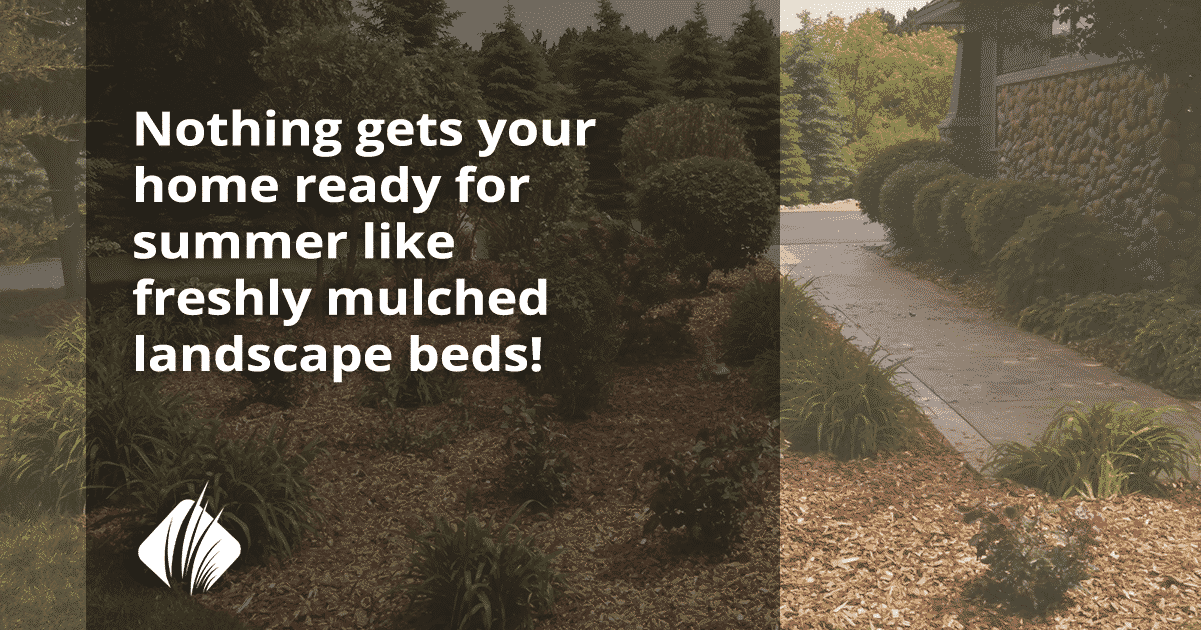
If you are ready to head into the spring and summer with a freshly mulched flower bed and home, then this mulching guide by Ebyland is for you!
We will take a look at some basics of mulch, the kinds of mulch, how much mulch you need, prepare your landscape beds, and end with other tips to make this your best mulching year yet!
Let’s dive in!
No time to read? Here's a summary:
- Mulch is any material spread on the ground to prevent evaporation and weed growth, with common types including bark, wood chips, and rubber.
- The benefits of using mulch include improving aesthetics, enriching the soil, reducing weed growth, conserving moisture, and preventing soil erosion.
- Potential disadvantages of mulch are that it can prevent healthy seeds from germinating and may encourage pests.
- The blog post provides a guide on how to calculate the correct amount of mulch needed and gives tips for preparing landscape beds and applying mulch effectively.
Interested in finding out more? Keep reading below!
1. The Basics of Mulch
If you have never mulched flower beds before, then this is a great place to start getting some useful background information.
What Is Mulch?
By its most basic definition, mulch is “a covering, as of straw, compost, or plastic sheeting, spread on the ground around plants to prevent excessive evaporation or erosion, enrich the soil, inhibit weed growth, etc.”
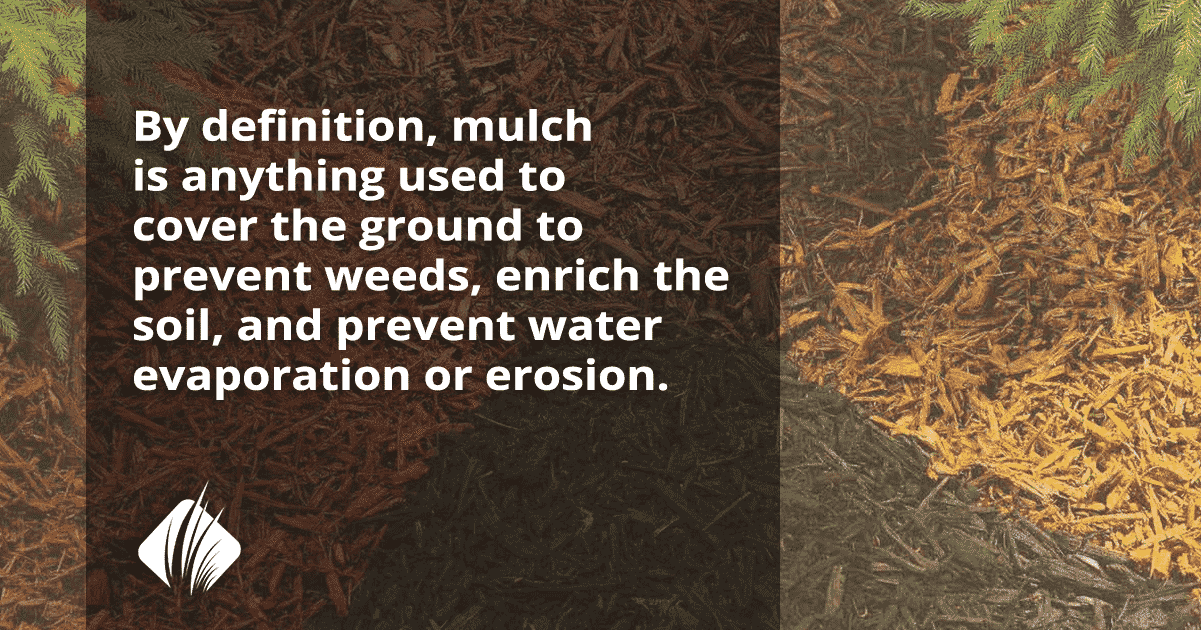
This definition is broader than what most people picture when they hear the word "mulch!"
Usually, people picture a pristine flower bed with some kind of bark/wood chip mixture on the ground to make the flower bed stand out beautifully against a lush, green lawn.
It is true that when people usually discuss mulch, they are often referring to the stereotypical bark or premium mulch sold by landscaping companies.
So how do straw, compost, and plastic sheeting fit into the "mulch" category?
The answer to this question lies in the purpose of the mulch--As we said, mulch can actually be anything spread over the ground to prevent the growth of weeds or to enrich the soil.
Here are a few common kinds of mulch and their uses:
- Bark and landscape mulch: Organic mulch made from tree bark and wood. People typically think about this when they hear the word "mulch."
- Compost mulch: Made of organic matter to improve the soil. This category includes mushroom compost, grass clippings, and other organic material.
- Sawdust mulch: Made from sawdust, this is a cheaper kind of mulch and works to keep down the weeds, but it doesn't add nutrients to the soil or have much aesthetic beauty.
- Straw mulch: Most commonly found in raised beds, gardens, or grass seeding, straw mulch helps retain moisture while allowing plants to grow. However, like sawdust mulch, it doesn't do much for aesthetics.
- Plastic sheeting: Although rarely referred to as mulch, plastic sheeting technically fits the definition and can help retain moisture and reduce weeds in the soil. Because it is not aesthetically pleasing, it is rarely found in a flower bed. Instead, you usually see plastic sheeting in greenhouses or fields.
- Anything that prevents weeds: As the definition states, anything used to cover the ground to help prevent weeds can be used as mulch. Newspaper, cardboard, rubber mats, carpet, and other materials can also be used as mulch.

As you can see, there are more uses and kinds of mulch than the standard landscape mulch that makes our flower beds and homes attractive!
For this article, when we use the word “mulch,” we are referring to the standard bark and landscape mulch most people think of when they hear the term.
Advantages of Mulch
When thinking about mulch, most homeowners immediately think of the aesthetic improvement mulch provides. Mulch certainly makes your property more attractive, but it has more benefits than increasing aesthetics.
What are some advantages of mulching?
- Aesthetics: We start with the most obvious one first! A fresh, dark layer of mulch makes a flower bed much more polished and attractive.
- Compost: Any organic mulch, including bark and premium blends, adds nutrients to the soil and encourages worms to live in the ground. This is important for any flower bed but particularly helpful in gardens, fields, and raised beds.
- Reduce Weeds: Weed reduction depends on several things, like the thickness and the type of mulch used. In a flower bed, the best way to ensure you have good weed reduction is to make sure the bed is weed-free and clean before you begin mulching.
- Conserve moisture: Mulch protects the ground from direct sunlight, resulting in the soil remaining cooler and losing less moisture. This is especially important in warmer climates or for fruit and vegetable beds.
- Reduces soil erosion: If applied correctly, mulch helps reduce the negative effects of heavy rains, such as soil washing away with rain.
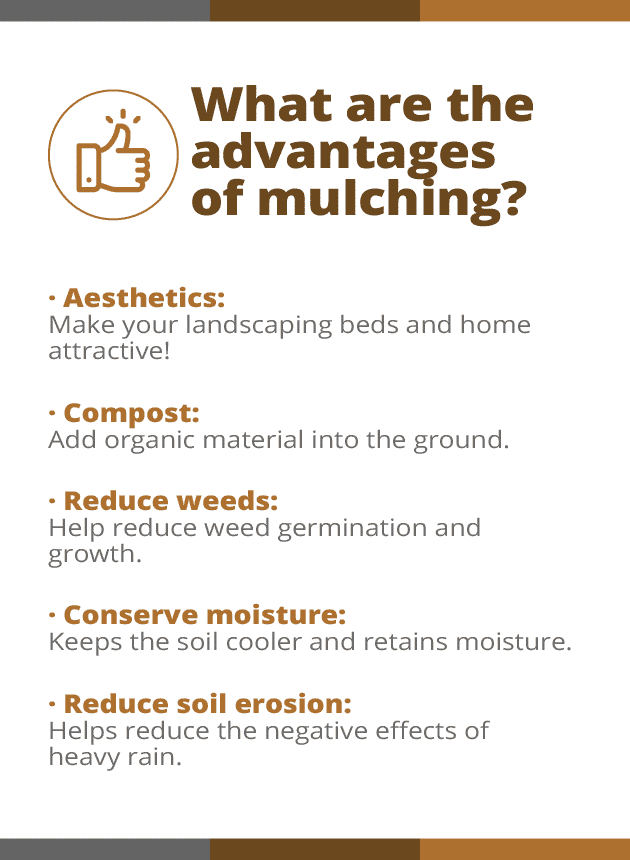
Suppose you want long-term sustainability and success for your flower beds or raised gardens. In that case, it is crucial to think about aesthetics and adding organic material back into the ground.
As we will see later in the article, bark, and premium mulch blends balance organic material and aesthetic beauty for your flower beds!
Disadvantages of Mulch
While mulch has many benefits for homeowners, it can have a few negatives, especially if you use it incorrectly:
- It can prevent seeds from germinating: Mulch helps keep weeds from germinating, which is good, but sometimes it keeps healthy seeds from germinating too.
- It encourages pests: Slugs, cutworms, and other pests prefer the cool, damp dirt provided by mulching.
- It doesn’t dry out quickly: If you get a lot of rain, mulch helps reduce erosion, but it is also slower to dry out. This can result in gardens or flower beds that are soggy for extended periods.
Thankfully, if you apply your mulch correctly and evenly, the effects of these negatives are not as significant. We discuss this later in the “How Much Mulch Do I Need” and “General Mulching Tips” sections.
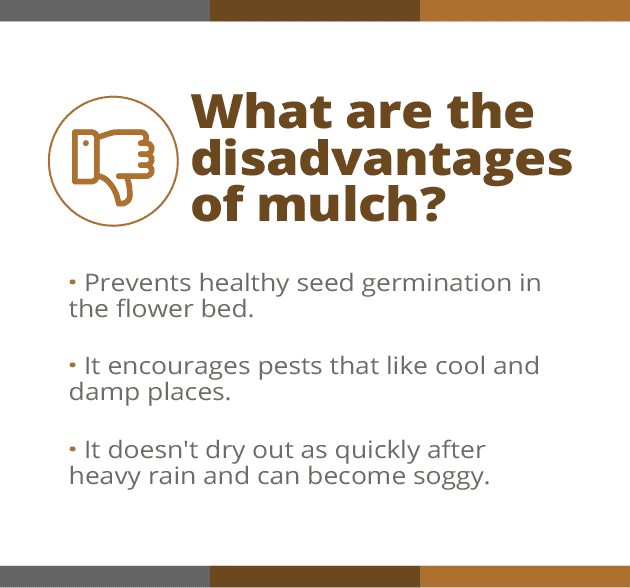
2. Kinds of Landscape Mulch
Now that we have some background for mulch let's look at a few of the most common types of landscaping mulch available for flower beds like yours.
If you live in Cumberland, MD, or the surrounding area, look at the available mulches at Ebyland to view our available products for purchase or delivery.
Bark Mulch
Bark mulch is 100% from tree bark without any hardwood added to the mixture. The texture varies depending on where you get it, but the more finely ground the bark mulch is, the quicker it decomposes and the more nutrients it adds to your soil.
Bark mulch is one of the best landscaping mulches for adding nutrients to the soil, especially when it is finely ground and screened to remove stones and large sticks. It decomposes quickly and helps retain ground moisture.
At Ebyland, we ensure that our bark mulch is only the best quality, finely ground, and screened to remove stones, sticks, and large pieces of bark.
Bark mulch has a naturally deep, dark brown color unless it is color dyed differently, such as black or red.

Premium Hardwood Mulch
Premium hardwood mulch is a mixture of bark mulch and hardwoods. Because hardwoods are used in the blend, premium mulch is usually ground several times before it is screened to remove sticks, stones, and other large wood pieces.
Premium hardwood mulch has a natural dark brown color similar to bark mulch. One of the main differences between bark and premium hardwood mulch is that premium hardwood mulch decomposes slower and adds fewer nutrients to the soil. This means it will last longer than bark mulch.

Color-Dyed Mulch
Color-dyed mulch adds color to give it a distinct and long-lasting hue. That way, you can achieve different aesthetics in your landscaping.
If you want a color other than the traditional dark brown color of natural mulch, then color-dyed mulch is a good alternative.
Common types are red mulch, black mulch, and brown-dyed mulch, but other options are available.
Each color brings a different aesthetic to a flower bed, and color-dyed mulch keeps its color longer. For example, if you like the natural brown look but want it to remain longer, you may wish to purchase brown-dyed mulch.
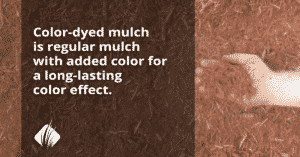
Playground Mulch
Playground mulch is one of the coarser wood mulch blends available. While it does contain some bark mulch, it is composed primarily of larger hardwood pieces.
Playground mulch is not ground up as finely as other types of mulch and contains larger wood pieces.
This results in a cheaper mulch, making playground mulch a cost-effective option in large areas, such as playgrounds, parks, picnic areas, etc. It's also slower to deteriorate than more finely ground mulches. However, it isn't always as comfortable to walk on as other types of mulch.
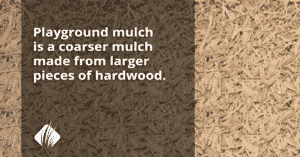
Rubber Mulch
Rubber mulch is an alternative to natural wood and bark mulch. Rubber mulch is made by grinding old rubber tires and other worn-out rubber products into small fragments. It provides a softer surface and makes an ideal surface for playground equipment like swings, slides, and playsets. Children won't be hurt if they fall off the swings onto soft, springy rubber mulch.
Because it doesn't deteriorate, rubber mulch is long-lasting and does not need to be replenished on an annual or regular basis. The only way it deteriorates is by being spread out and driven into the ground over time.
Finally, rubber mulch does not contrain nutrients, so it's not recommended to use for mulching plants or trees.
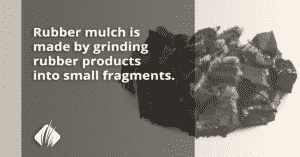
3. How Much Mulch Do I Need?
Before you start mulching, you'll want to know how much mulch you need. Since mulch products are sold by cubic yard, you need to know how many yards to order for your property.
To calculate how much mulch you need, you need to know three dimensions of the mulching area:
- The width in feet
- The length in feet
- The depth in inches
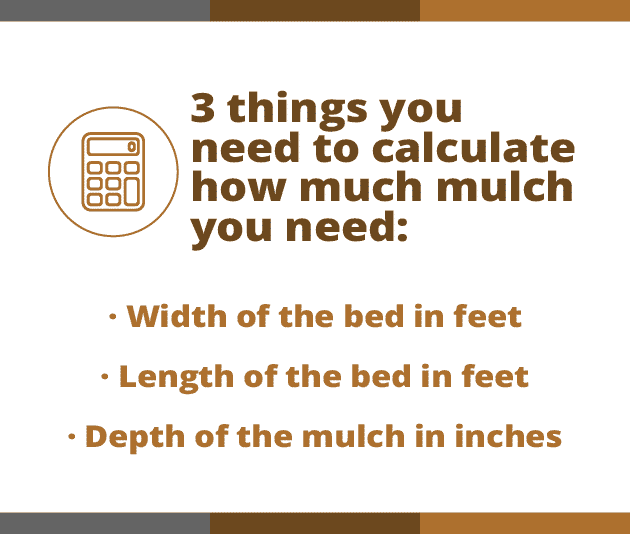
Keep reading to learn how to calculate your needed mulch manually, or use our Material Calculator on our Bark Mulch webpage!
If you have more than one flower bed or a complex landscaping bed, it is easier to break the beds up into smaller sections and take measurements on each section.
Once you have your dimensions ready, grab a calculator and get started!
- First, multiply the width and length of each section, giving you the area for each section.
- For example, if we have two beds that are 9x12 feet and 12x15 feet, we would multiply each bed separately.
- The smaller bed is 9’x12’= 72 square feet, and the larger section is 12’x15’= 180 square feet.
- Second, add all the areas together.
- In our example, we add 72 + 180 and get a total of 252 square feet.
- Third, know how deep you want the mulch. Here are recommended depths:
- 2” is the minimum depth recommended
- 3” is the recommended depth for established beds
- 4” is recommended for new beds
- Fourth, multiply your total square feet by one of the following:
- For 2”, multiply total square feet by 0.17
- For 3”, multiply total square feet by 0.25
- For 4”, multiply total square feet by 0.3
- In our example, we want the mulch 3” deep. We take our 252 square feet and multiply by 0.25 to get 63 cubic feet of mulch.
- Fifth, divide the cubic feet by 27 to convert to cubic yards.
- We take 63 cubic feet and divide by 27 to get 2.3 cubic yards.
- Round up to the nearest half cubic yard to ensure you have plenty of mulch.
- For example, we round 2.3 to 2.5 or even three cubic yards of mulch.
- You are ready to place your order!
4. Preparing your Landscape Beds for Mulch
Now that you've ordered your mulch, it's time to get your landscape beds ready.
Here are some things to do to prepare your beds:
- Kill and remove all weeds - Make sure all weeds are killed and removed from the bed before applying your mulch. You can either pull the weeds or spray them with herbicide. If you use herbicide, do it a couple of weeks before you mulch so you are sure the weeds die entirely, and remember to be safe!
- Trim bushes in the bed - Any annual trimming should be done before mulching to prevent leaving trim scraps or footprints on your new mulch. Nothing looks nicer than a fresh, unbroken layer of mulch!
- Rake and smooth out the bed - Rake out all the stones, sticks, and other debris in the landscape bed. As you rake out debris, you also want to smooth the dirt (or previous mulch) in the bed and remove any high spots or clumps.
- Edge the bed - Edging a mulch bed provides an aesthetic contrast between the mulch and the surrounding yard. You can use a hand edger or a powered edger.
- Add weed prevention - You can help prevent new weeds from germinating by adding weed prevention such as Preen Weed Prevention or landscaping fabric. If using landscaping fabric, remove any old mulch in the bed and follow the fabric directions carefully.
When your landscape bed is free from weeds, debris, smoothed out, edged, and has weed prevention, you are ready to apply the mulch!

5. Mulching Tips
Here are a few general mulching tips to help the work go smoothly!
- Don’t over-mulch. If you have an established mulch bed, 3” is a good depth. If you are starting a new mulch bed, 4” is a good depth.
- Make small basins in the mulch around trees and bushes. This captures needed water for the trees and pools it instead of the water running off.
- Use gloves. Mulch is dirty, and color-dyed mulch leaves a temporary stain on your skin and fingernails. Gloves also protect your hands from splinters and cuts.
- Don’t cover or smother plants. Make sure all the leaves and flowers are clean of mulch.
- Distribute the mulch evenly. Whether you use a rake or your hands, flower beds are more appealing when the mulch is evenly spread.
- If mulch is delivered, put a large tarp down and dump it on that. If the mulch is dumped directly on a large tarp, cleanup is clean and quick!
Conclusion
No matter what size your landscaping beds are or what plants and flowers you have in them, mulching always increases the aesthetics and appeal of the flower beds and your home.
If you live in the Cumberland, MD, area, then stop by Ebyland LLC. We offer a wide range of products for your outdoors - including mulch, landscape supplies, outdoor playsets, outdoor furniture, plants, outdoor living, and much more.
With our well-stocked inventory combined with our friendly customer service, we will make sure we give you the ideas and products that you need to make your backyard beautiful!
Stop by the Ebyland store today; we look forward to seeing you!





